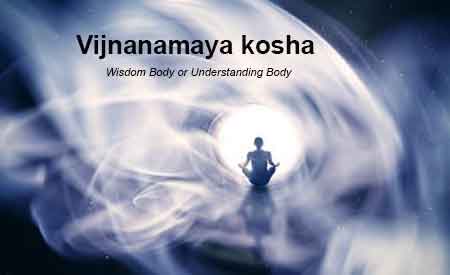Introduction
The fourth layer out of the five koshas in yoga is known as the Vijnanamaya Kosha (Wisdom Body or Understanding Body), which is the wisdom sheath. It is made up of intuition and intellect, and it can be referred to as the witness mind – the aspect of our consciousness that is not completely wrapped up in what we are doing or thinking, but is acutely aware of our current activities and thoughts. Lets Explore here What is Vijnanamaya Kosha ?

What is Vijnanamaya Kosha?
The Vijnanamaya Kosha is the wisdom body and it is composed of the higher faculties of discrimination and understanding. This is the layer that helps us to access our intuition and to develop greater insight into our lives.
When we practice yoga, we are working with the wisdom body to cultivate wisdom and insight. We can use meditation to explore our higher faculties and to gain clarity and understanding. We can also use mindfulness to explore our intuition and to become more connected to our inner guidance.
The wisdom body is the bridge between the mental and spiritual bodies, and it is important to take the time to explore it to gain the full benefits of yoga. By taking the time to explore the wisdom body, we can become more in tune with our intuition and gain greater insight into our lives. Ultimately, vijnanamaya kosha is awareness in its simplest form.
How to activate Vijnanamaya kosha?
The Vijnanamaya kosha can be activated through various practices such as mindfulness, meditation, and yoga. Mindfulness helps us become aware of our thoughts, feelings, and physical sensations in the present moment without judgment.
Meditation allows us to observe our thoughts without reacting to them and gain insight into our innermost feelings. Finally, yoga poses help to bring balance to the body and mind while promoting an awareness of the connection between the two.
By engaging in these practices regularly, we can strengthen our connection with the Vijnanamaya kosha and become more mindful of our thoughts, feelings, and experiences.
It is also possible to strengthen the Vijnanamaya kosha through a healthy mind-body diet, spending time in nature, engaging in creative activities, and cultivating self-compassion.
Vijnanamaya kosha and Meditation
Meditation is one of the most effective ways to activate the Vijnanamaya kosha. Through meditation, we can become aware of our thoughts and feelings without judgment and gain insight into our innermost selves. During meditation, it is important to focus on your breath and be mindful of your body and mind.
This helps to bring balance to the body and mind while promoting an awareness of the connection between the two. By regularly engaging in this practice, we can strengthen our connection with the Vijnanamaya kosha and become more mindful of our thoughts, feelings, and experiences.
Through this awareness, we can discover a deeper sense of peace and self-acceptance. Meditation can be done in many ways and at any time. It can be performed in a group setting or individually. There is no “right” way to meditate. It is important to find a place that is free of distractions and comfortable.
Vijnanamaya kosha and Related Chakras
The Vijnanamaya kosha is associated with the Ajna, or third eye chakra. This chakra is located between the eyebrows and is associated with intuition, insight, and understanding. This chakra helps to connect us to our inner wisdom and to our higher self.
When this chakra is balanced, we are able to access our intuition more easily and make decisions based on inner knowing rather than external influences. The Vijnanamaya kosha is also connected to the Vishuddha, or throat chakra.
The Vishuddha chakra helps us to express ourselves more clearly and authentically. When this chakra is balanced, we can speak our truth without fear of judgement or criticism from others. We can also better understand our own thoughts and feelings in order to make decisions that are aligned with our highest truth.
Conclusion
The Vijnanamaya kosha is an important part of the five-layer model of consciousness in Hinduism. It represents the mental body which contains all of our thoughts, beliefs, ideas, and perceptions about ourselves and the world around us. Through meditation and related practices such as yoga and pranayama, we can learn how to connect with this layer of consciousness in order to gain insight into ourselves and become more mindful of our thoughts, feelings, and experiences.



